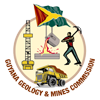Careers
Drilling for petroleum on the coast of Guyana is based on an expectation that Petroleum evolved in the Guyana Basin Offshore. Guyana would migrate updip from the deeper parts of the sedimentary basin offshore, to the coastal fringe in the onshore. Most of the exploration work in the onshore coastal domain has been focused in the Berbice County since this is where the thickness of coastal sediments in which petroleum is expected to be found is the thickest. Westwards towards the Waini River, sediments become thinner.
Drilling is the end-point of an exploration concept that performs the test of where petroleum is present. In petroleum exploration, like solid minerals exploration, several methodologies are employed. Geological, geochemical and geophysical applications are the foremost technologies used on land but offshore, geophysical applications dominate.
Typical geophysical applications are aeromagnetics, which depend on the magnetic minerals in igneous basement rock to give a “picture” of the structural features of the basement to which the overlying sediment tends to conform. An aeroplane, flying at a fixed height, record signals from which a map of the broad regional features.
Seismic methods utilise energy waves into the subsurface that refract and reflect the formation boundaries and recaptured using a streamer. The recaptured reflections are processed as wavelets by computers and the end product is a cross-section of the subsurface of the earth showing the sequence of formation layers with the structural features. A study of a seismic map pinpoints targets for drilling.
Common geochemical applications test the soil for traces of hydrocarbons that have made their way to surface. Results from geochemical applications can be combined with the geology and geophysics to improve the chance of finding petroleum when a target is drilled.
The term “reservoir rock” is given to the rock types in which petroleum is found. Examples of these “reservoir rock” are sandstones, limestones, and dolomites.
Reservoirs of petroleum in the subsurface are created when the petroleum is unable to migrate upwards and escape to surface, and is contained in an area. The term “cap rock” is given to the impermeable rock type that prevents migration of petroleum. An example of such is shale. The term “trap” is a finite area where the reservoir of oil is contained in the subsurface and is the location that geologists look for to drill for petroleum.
Petroleum exploration is very costly. Millions of dollars are spent in this risky business. It also offers an exciting career in a technical science field. Geology, Geophysics, Geochemistry, Petroleum Engineering, Drilling Engineering, Geological Engineering, are some of the common professional areas that can lead someone into a career in a the petroleum sector. A solid foundation in science is needed, especially for the engineering professions.
There are also other career paths that could lead to a career in the petroleum sector; these are technology-based careers where someone could become especially competent in the instrumentation and methods for dealing with drill cores and samples, or operating a drill or conducting special surveys.
In such cases, the Petroleum Technologist is a sub-professional and works to the demands of the Petroleum Engineer or Geophysicist, for example.
In a fully developed petroleum sector, there are opportunities for many types of skills to be engaged. The Guyana Geology and Mines Commission is fully expectant that this will be the case as petroleum exploration expands.
Examples of Specialty Areas
GEOLOGIST
- Maps the surface features of terrain
- Interprets seismic and maps subsurface features therefrom
- Is involved in well site activities
GEOPHYSICIST
- Conducts remote methods for imaging the subsurface commonly utilising seismic, aeromagnetics, gravity
GEOCHEMIST
- Analyses for existing chemical substances in the subsurface that could direct the explorationist to the prize
PETROLEUM ENGINEER
- Is involved in most applied aspects of petroleum operations other than geological aspects
- Reservoir modeling and analysis
- Drilling and Production issues
DRILLING ENGINEER
- Specialises in petroleum exploration and production drilling
Some other occupations in the industry
There are various skills needed in the oil and gas industry; skills needed for exploration, maintenance of existing wells, and for petroleum processing. This group includes exploration and production workers, executive, managerial and professional, clerical and administrative support workers.
The professions and what they do are given below:
Petroleum Engineers
- Tries to understand the geologic formation and properties of the rock containing the reservoir, determine the drilling methods to be used, and monitor drilling and production operations. They design equipment and processes to achieve the maximum profitable recovery of oil and gas, often using computer models to simulate reservoir performance using recovery techniques.
Paleontologist
- One who studies fossil remains at the study area.
Mineralogist
- One who studies the physical and chemical properties of mineral and rock samples.
Stratigrapher
- One who determines the rock layers most likely to contain petroleum
Photogeologist
- One who interprets and examines aerial photographs of land surfaces
Drilling Superintendents
- Supervises drilling crews, either one or more drilling rigs
Rotary Drillers
- Supervises the crew and operate machinery that controls drilling speed and pressure.
Roughnecks
- Help guide the lower ends of pipe to well openings and connect pipe joints and drill bits.
Roustabouts
- Do oil field maintenance and construction work.
Party Chief
- One who is in charge of the entire seismic operations especially in its daily administration.
Observer
- Operates and maintains electronic seismic equipment.
Electricians, Welders, Instrument repairers, and laborers
- Maintain equipment within the various areas of the industry.

